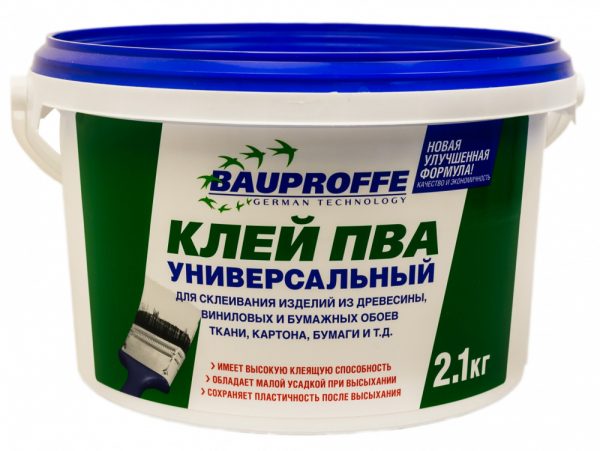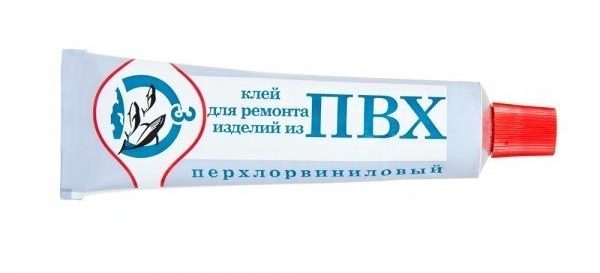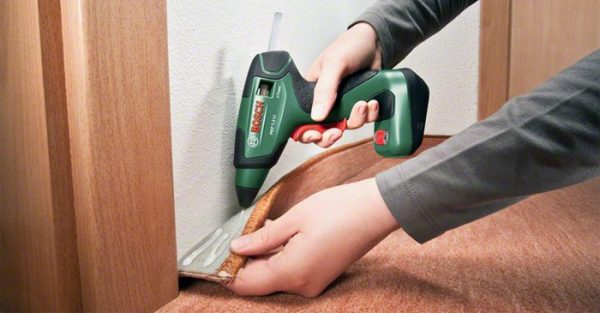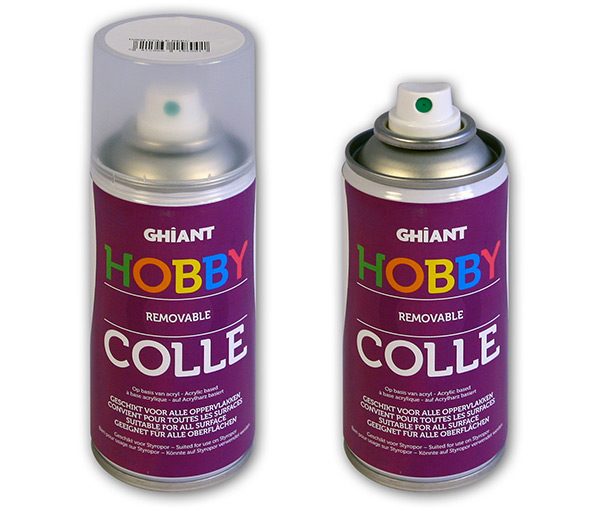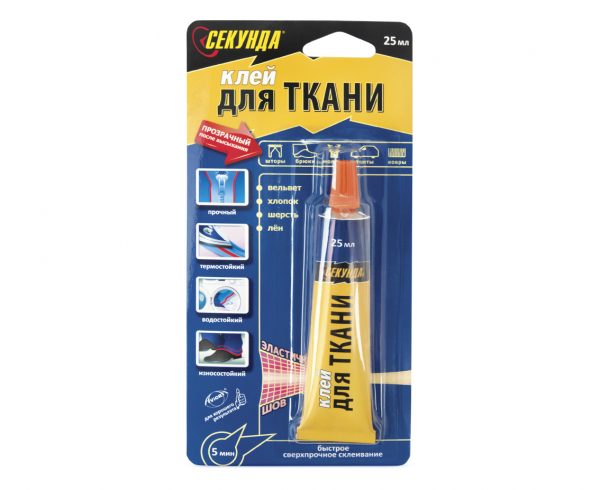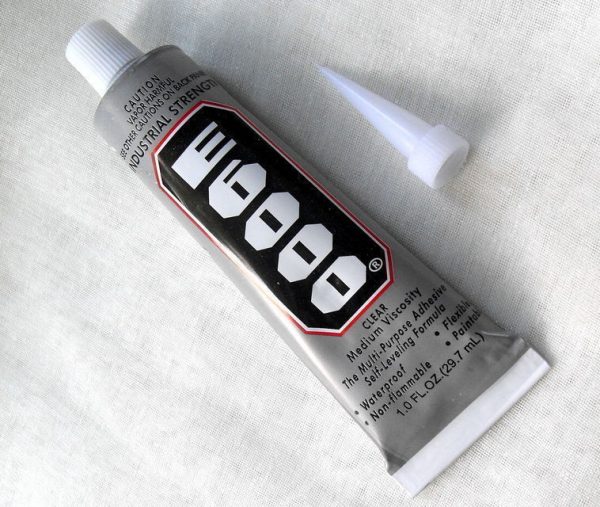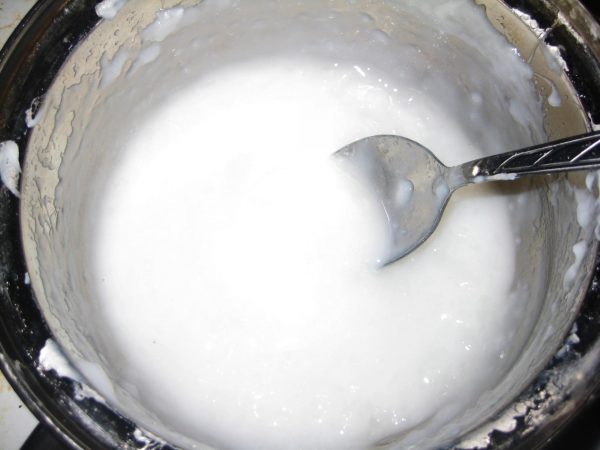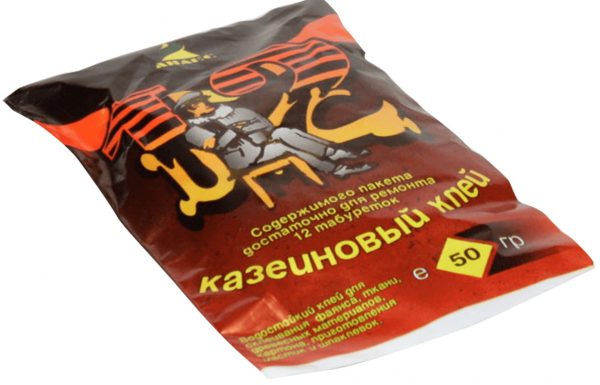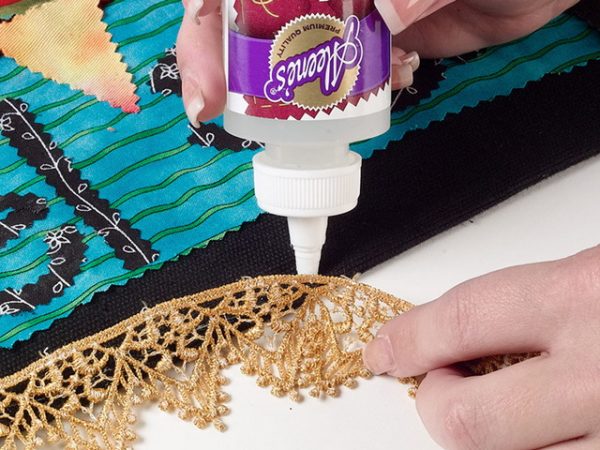In everyday life, needlework, creativity, they often use such a technique as gluing fabrics to each other or other materials. The same method is used in the furniture industry, car lining repair. It will help to implement the planned high-quality glue for the fabric, which, following the instructions, will fix the material firmly for a long time.
- Features of the use of various compounds
- Types and types of adhesive
- Rubber compounds
- Perchlorovinyl adhesive
- Glue for fabric "liquid thread"
- Nitrocellulose composition
- Hot glue
- Polyvinyl acetate glue
- Glue spray
- Adhesive Tips
- Brands and Costs
- How to make glue yourself
- Usage Technique
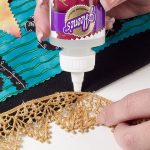
Features of the use of various compounds
The reliability of the made adhesive seam and the possibility of using the product in the future directly depend on the type of textile glue. There are many types of adhesives that are used for gluing textiles to other materials, fixing rhinestones and other decor. Their main characteristics:
- PVA - is considered a universal glue that is used for needlework, especially for decoupage, some types of polyvinyl acetate products are moisture resistant;
- rubber and latex - suitable for leather, fabric, foam, do not damage the structure of the material, therefore suitable even for delicate structures;
- polyurethane - designed for dense fabric, PVC, other materials - metal, wood, plastic;
- Nairitic (based on neoprene) - a transparent, water-resistant composition, can stick all types of textiles, materials for shoes, gives a very strong seam;
- hot glue - safe for humans, resistant to water, chemicals, colorless;
- perchlorovinyl - designed for textiles, leather, rubber, most often used in shoe production;
- styrene butadiene - an elastic agent that does not deteriorate from the action of UV rays, high, low temperatures, water;
- nitrocellulose - used to adhere skin to tissue, as well as to bond together complex types of matter.
Types and types of adhesive
It is best to select glue for clothes, furniture among proven compounds that do not exactly spoil the material, although it is necessary to specify suitability for a particular fabric in each individual case.
Rubber compounds
If you need to carry out a high-quality repair of clothes, glue the internal elements of the suit, perform other work with the fabric without marks and stains, it is better to use rubber glue. Such agents are solutions of synthetic or natural rubber with vulcanizing agents. You need to purchase non-toxic compounds in small packages that are designed for rubber and fabric. They are applied in a thin layer, and after some drying, the processed parts are pressed against each other.
to contents ↑Perchlorovinyl adhesive
This is a solution of perchlorovinyl resin in organic solvents with the addition of plasticizers. The glue is characterized by high heat resistance (up to +100 degrees), moderate frost resistance (up to -20 degrees), resistant to water, oil, gasoline. It is applied in 2 layers: the second - 10 minutes after the first. The product will be ready for use in 2 days.
to contents ↑Glue for fabric "liquid thread"
Compounds of the type "liquid thread" are widely used in needlework, especially when combining different materials. They are well suited for gluing rhinestones, fringes, appliqués, patches, fastening spider webs, coconut threads, felt, felt. Glues are characterized by accuracy of application and uniformity of the layer, high adhesion to the surface, transparency. Funds dry in seconds, do not damage the matter, even beginners can use them.
to contents ↑Nitrocellulose composition
Adhesive based on nitrocellulose, solvents and plasticizers is most often used in shoe factories. In addition to leather, they can combine durable types of fabric - Bologna, banner, membrane, etc. After gluing, it is required to crush the products with the load until the glue reaches its final strength.
Hot glue
Such products can be found on sale in powder form and in the form of glue sticks. In the first case, dilution is required until the finished composition is obtained, in the second case the glue must be melted with a special gun. Hot melt adhesives provide a high degree of adhesion, lack of spots, environmental friendliness, reliability of the seam.
to contents ↑Polyvinyl acetate glue
PVA can be used for permanent and temporary fixation of products, because if desired, it can be washed off the fabric after washing. Conventional polyvinyl acetate adhesives do not tolerate moisture, but now there are modern moisture resistant compounds and even two-component products that can withstand direct contact with water. In most cases, PVA is still used in decoupage, the creation of children's crafts from fabric, and gluing applications.
to contents ↑Glue spray
Aerosol adhesives differ only in the form of release - the composition is poured into small spray cans. Such products are conveniently sprayed onto the surface to be treated, and can be applied to any area. Also, glue spray for fabric is used to fix patterns, stitching zippers, laying out basting, processing the edges of the fabric. The shelf life of the adhesive in the aerosol is large, because the solution does not come in contact with air.
to contents ↑Adhesive Tips
Before buying, it is important to carefully read the description of the properties of the sold adhesives. The fabric has a flexible structure, is deformed, and is subjected to regular washing. Therefore, the adhesive joint must be very strong, withstand various loads - ironing, stretching, squeezing during washing, contact with water, household chemicals, UV radiation. Only glue with such capabilities is able to ensure the proper quality of the product.
Also, when buying, you should pay attention to the following properties of textile glue:
- lack of an unpleasant smell;
- composition transparency;
- optimal consistency, preventing the glue from draining;
- resistance to any damaging factors;
- the impossibility of penetration in the form of spots on the front side of the product;
- optimum terms of solidification and full drying.
The glue should create an elastic film on the material, which not only firmly glues, but also provides protective properties, maintains a certain extensibility of the material without forming a rigid seam. The integrity of the adhesive bond should not be disturbed by the movement of the fabric fibers, therefore superglues and similar textile products are not suitable. Glue should be chosen depending on the type of fabric - silk, wool, cotton and other natural materials, synthetics, leather, etc. If necessary, you can buy a universal tool that will be suitable for any textile.
to contents ↑Brands and Costs
Inexpensive adhesives usually cost between 40-80 rubles per tube or bottle of small size. Imported funds often have a higher price (from 120-200 rubles), as well as some popular domestic brands. The following are the most popular fabric adhesives among users:
- "Guterman" (280 rubles). Suitable for jeans, felt, linen, cotton, it is also used for final processing of the back side of the embroidery in order to consolidate it. Solvent-free, suitable for dry cleaning, washing. Immediately after application, the composition can be removed with plain water.
- Decola (130 rubles). Thick, dense adhesive that cannot be diluted, otherwise it will lose its properties. It is not very convenient to apply the product, but it perfectly holds together dissimilar materials, ideal for applications.
- Mod Podge Fabric (220 rubles). The glue line made by him does not deteriorate from hand washing using non-aggressive powders and liquid detergents. The coating will be very beautiful, glossy, in addition, it will additionally protect the fabric from damage.
- JAVANA (260 rubles). When applied, it creates a matte finish that is fixed by ironing. The tool is well suited for working with the thinnest napkins, decoupage paintings.
- UHU Textile (230 rubles). This glue is waterproof, it is considered universal, as it is suitable for almost any textile materials and synthetics. The tool is not afraid of ironing, drying on batteries.
- "Second" (80 rubles). This composition is also considered universal, but, in addition to applying to the fabric, it can be used for bonding leather, ceramics, porcelain, foam rubber. It freezes almost instantly, so you need to work with it quickly.
For gluing rhinestones, it is recommended to use special adhesives that provide reliable fastening and beautiful appearance of crafts. Such tools are best suited:
- “Crystal moment” (70 rubles). Absolutely transparent composition, easy to apply, dries quickly, forming a film. The expense of the product is minimal: a tiny drop is enough to attach the rhinestone, but due to the instant setting it will be difficult to adjust its position.
- Fevicryl (180 rubles). Contains epoxy resin, so it is not afraid of moisture after drying. Applied from a convenient nozzle is strictly dosed. At first it has a white color, but after drying it becomes transparent.
- E 6000 (90 rubles). Viscous transparent glue from China. It has a high degree of adhesion to various materials, elastic, plastic. It can be used even for rhinestones with foil inner surface.
How to make glue yourself
Often, needlework people prefer to use high-quality Mod Podge Fabric glue. But its price is quite high, and the expense is high, so you can try to make the composition with your own hands.
There are two options for making fabric glue. For the first recipe you will need:
- 225 ml of any PVA;
- 112.5 ml of water;
- 2 tablespoons of glitter (if necessary);
- 2 tablespoons of varnish (acrylic or other water-based).
It is necessary to take a jar with a tightly screwed lid, wash it clean, dry it. The volume should be at least 350-400 ml. Pour the measured PVA glue into the jar (instead of it it is allowed to take acid-free glue for scrapbooking, it is more resistant). Add water to PVA, mix, inject varnish and sparkles. The last component is optional. Close the lid, shake the glue again. Keep refrigerated.
For the second version of the glue, the following ingredients are needed:
- 210 g flour;
- 56 g of sugar;
- 225 ml of cold water;
- ¼ teaspoon vegetable oil;
- ¼ teaspoon of vinegar.
Prepare a jar for 350-400 g, wash. Sift flour into the pan, add sugar, pour water. Beat the mass with a whisk to get rid of lumps. Turn on the fire, heat, but do not let it boil. If the glue is thick, it can also be diluted with water. At the end of cooking, introduce vegetable oil. Remove from heat, pour vinegar. Cool glue, store in a jar in the refrigerator.
You can also make your own dextrin glue for the fabric. To do this, starch is fried in an oven at a temperature of +160 degrees for 2 hours. Ready dextrin combined with boiling water 1: 1, stirred until dissolved. It must be applied immediately, since the glue hardens very quickly.
The fabric can also be glued with a casein compound.For its manufacture, 2 parts of casein powder and 1 part of water are mixed, heated without boiling until the mass becomes homogeneous. Casein is sold in stores in the form of dry powder, it is inexpensive, but the finished glue has a drawback - it soon hardens. Therefore, you need to prepare the composition in small portions.
to contents ↑Usage Technique
Before bonding, the flaps of the fabric must be cleaned of threads, foreign objects. Then glue one or both surfaces (as indicated in the instructions) with glue, leave to dry. After they must be carefully pressed together or put under a press machine. Polymer adhesives are usually applied on 2 layers, the second - 10-15 minutes after the first. The fabric will be ready for use in 2-24 hours, which is also prescribed in the instructions. Tips for using textile adhesives:
- care must be taken when applying the composition, some types of glue are poorly removed from matter;
- for stronger, thicker fabrics it is better to choose an adhesive with a high degree of adhesion;
- for light-colored clothing, you must always acquire an absolutely transparent composition, which after drying does not change color;
- if it is convenient, you can use a special gun to extrude glue;
- it is worth acquiring only environmentally friendly, hypoallergenic compounds if the tissue comes in contact with the skin.
It is better to wash things no earlier than 3 days after the moment of gluing the fabric. This will help the composition gain its final strength and not collapse from the action of water and detergents. To remove glue residues, use vinegar, alcohol, acetone or buy specialized products.

